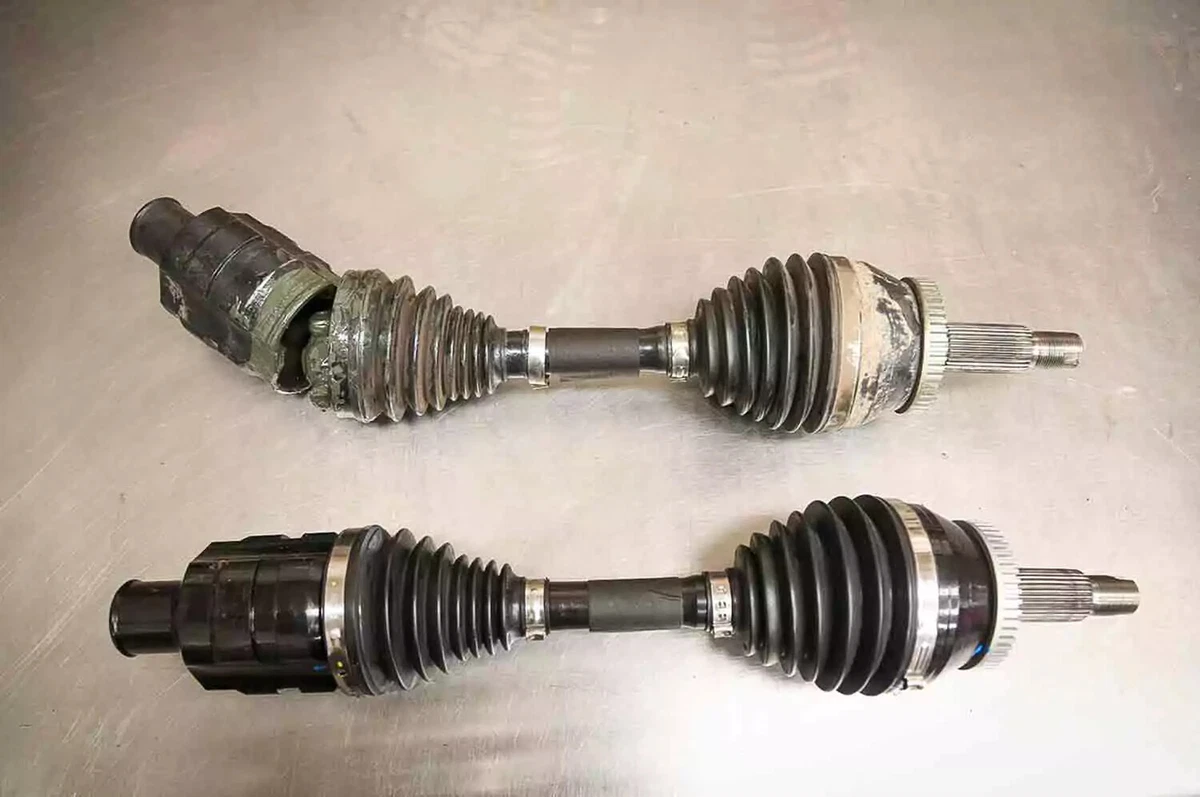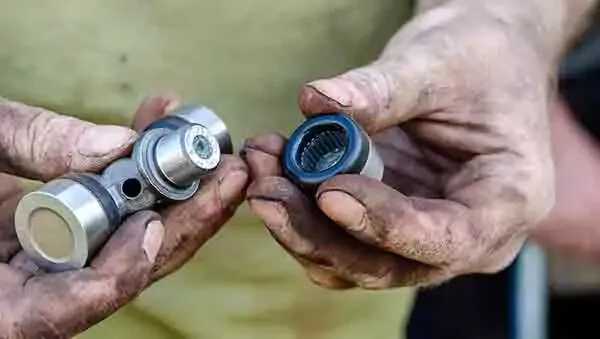Most front-wheel drive (FWD) and all-wheel drive (AWD), as well as some four-wheel-drive (4WD) and even rear-wheel-drive (RWD) vehicles, use special articulating axles. CV axles transfer the power from the engine to the wheels.
They are strong and durable, but as with any moving part, they have a limited lifespan. Eventually, CV axles and joints need to be replaced.
What a CV Axle Does

CV axles are durable, but they don’t last forever.
CV stands for constant velocity. The CV axle rotates at the same speed end to end regardless of whether the suspension is going up or down or the wheel is turning left or right.
Both ends of the CV axle are splined. At the outer end, that allows engagement with both the transmission and wheel hub. The inner allows slight movement in and out with suspension and steering movement. Each end has a joint. The outer joint is a fixed joint with sliding bearings to allow for steering angle changes. The inner needs to accommodate vertical pivoting and sliding. A single nut and cotter pin retain the outer joints, and a snap ring secures the inner joints.
Signs of a Failing CV Axle

The broken CV joint (top) is fully separated. It is not repairable and must be replaced by a new CV joint (bottom).
The most common symptom of a bad CV axle is clicking and popping when turning at low speeds. As time goes on, the noises get worse. Eventually, you may notice vibration from the bad axle. (This is side-specific. The bad side vibrates.) Once you have vibration, the axle is near its failure point.
Every CV axle has a boot that holds grease in the joint. The most common failure cause of CV axles is a torn boot, which allows the grease to sling out. If you see a torn boot or grease around the axle, this is a ticking time bomb. The sooner you fix the boot, the more likely you are to be able to save the axle from failing. Replacement boots require removing the axle. Axle boot repair sleeves can be used without removing the axle.
Replacing a CV axle can be tough, as sometimes they don’t want to come out of the transaxle. See our guide on replacing a CV axle - opens in new window or tab. for complete step-by-step instructions. Depending on the vehicle, you may need a full axle or just the CV joint.
Don’t Drive With a Broken CV Axle

Special axle tools like this one are often required to remove the axle from the transaxle. This is attached to a slide hammer, which helps pull the axle out.
You cannot safely drive with a broken CV axle. You might be able to remove the axle from the wheel hub with the inner shaft connected (so the transaxle does not leak), but this is only to move the vehicle into position for repair. Your vehicle will set off multiple codes. Simply stated, driving with a broken axle is a risky proposition.
How long do CV axles last?
Most CV axles last well over 100,000 miles. This is not a periodic replacement part. These are replaced on an as-needed basis. Unless you got in an accident or have specific damage, replacing both axles together is a good idea. If they are the same age, they have the same wear and tear. If one axle is bad, the other axle is likely on its way out as well.
How do you test for CV axle problems?
You can test your CV axle by simply driving slowly in an open parking lot and making sharp turns back and forth. Listen for popping and clicking. Feel the steering wheel for jerks and pops. If you get any of these, your CV axle is likely on its way out.
Can you rebuild a CV axle?
Replacement axles are relatively cheap. You can’t rebuild a CV joint for less than you can buy a new one. If your vehicle has hard-to-find CV axles, you can consider rebuilding. But most of the time, replacement is the better option, especially for the novice DIY wrench-turner.
Another option is repacking. This is not a complete rebuild but rather a refresh. In this case, you remove the axle from the vehicle, cut away the boot, clean and wash the joint, and then pack it with fresh axle grease. Finally, you install a new boot and the overhauled CV joint. If the joint is in good shape but the boot was torn, this is a good option.
CV Axle Cost: Why People Buy Axles, Not Joints

Most vehicles require disconnecting some of the suspension to get the axle out of the wheel hub.
Because the type of axle and joint varies wildly, so does the cost. You can get a replacement joint for $50 to $100. An axle assembly typically costs between $150 and $500. However, the work of replacing one joint versus the whole axle is the same. Given that you should replace these joints together, swapping out the whole axle is the smart money move.
Should you inspect and replace other parts while working on your CV axle?
Yes. You could opt to replace the wheel bearings and seals. You are already in there and did the hard part of removing the axle. Replacing the bearings addresses common issues around the axle.
In most cases, you have to remove the tie rod ends and at least one ball joint, so you are already halfway there. Replacing those items not only freshens up the ride, but loose ball joints can put undue stress on the axle. We also recommend going “full send” by rebuilding the front suspension while it’s apart, especially if they are original to a relatively old vehicle.
Share your feedback
This article is meant to provide general guidance only. Automotive maintenance, repair, upgrade, and installation may depend on vehicle-specifics such as make and model. Always consult your owner's manual, repair guide for specific information for your particular vehicle and consider a licensed auto-care professional's help as well, particularly for advance repairs.
































